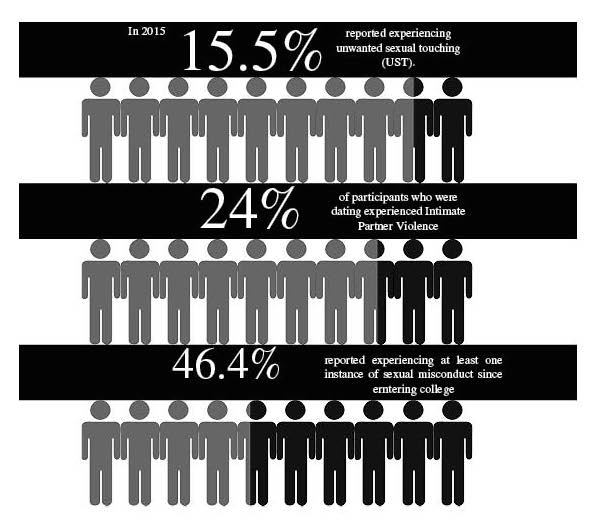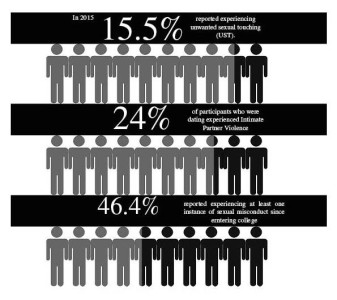flemingt17@grinnell.edu
Last Sunday, Nov. 10, members of the campus community learned the results of the campus-wide 2015 Sexual Conduct: Culture and Respect survey. Among other developments, the survey revealed that while the overall number of sexual assaults reported by participants has not decreased since the survey was last issued in 2013, the number of incidents of unwanted sexual touching has decreased significantly.
The study was created and analyzed by Professor Christopher Ralston, Psychology, along with Tyler Anderson ’16, Rachel Cusick ’17, Jen-Ai Notman ’16, Hayley Levin ’16, Nele Löcher ’17 and Erin Weber ’16, who worked over the summer to analyze the results of the survey as part of a Mentored Advanced Project.
The survey measured five major forms of sexual misconduct: stalking, intimate partner abuse, unwanted sexual communication, unwanted sexual touching and sexual assault. Ralston explained that the biannual survey, which was first issued in 2013, was intended to help track the efficacy of the College’s programs which aim to prevent sexual misconduct. It also represented an attempt to remedy the gap that Ralston found in existing research on sexual misconduct.
“The research literature as it existed at that time really was filled with research studies that weren’t particularly well conducted, and the results were tentative at best,” Ralston said in his introduction to the presentation. “To be honest, there wasn’t a whole lot out there that did seem effective.”
The survey found that while 42.4 percent of participants experienced some form of sexual misconduct in 2013, that number fell to 31.1 percent in 2015. Ralston said that this change can largely be attributed to the significant decrease in unwanted sexual touching reported by participants. The survey also noted that parties at Harris and Gardner continue to be the places where students are most at risk to experience unwanted sexual touching.
While in 2013 4.7 percent of participants reported experiencing an attempted or completed sexual assault, in 2015 4.0 percent of participants reported such an experience. Ralston noted that this drop is not statistically significant and expressed disappointment that the survey did not indicate a decline in rates of sexual assault.
“I was disappointed, I think, also because there have been efforts—active bystander training, consent definition training, and NSO, and campus dialogue and just sexual assault being more on people’s minds,” Ralston said. “You would kind of hope that these things [would] converge a little bit to make an impact, and so I will say certainly I was disappointed that we didn’t see that rate go down farther.”
Notman, whose research focused in intimate partner abuse, said that she was most surprised to learn that 21.4 percent of students in dating relationships had experienced some form of intimate partner abuse, which included controlling behaviors, pressure and threats or violence. Moreover, Notman said the survey results reveal a lack of knowledge about what constitutes intimate partner abuse. She suggested that the College could do more to educate students about the signs of abusive relationships and make them aware of the resources which are available.
“We haven’t, as an institution, really been focusing on intimate partner abuse even though it’s one of the highest rates on campus and has huge detrimental consequences,” Notman said. “People are coming into college and having their first serious relationships, so it’s a really important time.”
Löcher called attention to the statistic that 50 percent of participants who experienced sexual assault reported that there was an opportunity for bystander intervention. The survey found that receiving active bystander training was not significantly related to engagement in active bystander behaviors. Löcher suggested that the bystander programs currently in place are not sufficient.
“I think it’s unrealistic to expect that an hour and a half at the beginning of your freshman year is going to significantly impact how you’re going to act,” Löcher said.
The survey also made note of what groups of participants were most at risk for various forms of sexual misconduct. Participant groups most at risk for any form of sexual misconduct included cisgender female students, transgender or non-binary students, non-heterosexual students and domestic students of color.
“Half of first-year female-identified students had experienced, by March or April of the year they took the survey, some form of sexual misconduct,” Ralston said. “Those are pretty high rates. Shockingly so, if I do say so myself.”
Title IX Coordinator Angela Voos anticipated that the results of the survey would have a significant impact on the College’s future efforts to prevent sexual misconduct.
“I just see so much opportunity, because we know concrete things about our climate that we can develop programs around. And we can focus the programs,” Voos said. “We need to prioritize—what are the most important things we can do to reduce our sexual assault, and sexual misconduct in general?”
At the presentation’s close, Anderson announced the formation of a new group, Students Promoting Sexual Respect, which will work to build upon the results of the survey and prevent sexual misconduct on campus.
“We’re creating a new student group to harness that energy, because many of you in this room want to do something about this problem and so do we,” Anderson said. “Everyone is welcome, including those that are passionate, lukewarm or skeptical. The only requirement is a respect for others’ experiences and a desire for real change.”
Ultimately, according to Ralston, the responsibility to respond to the survey lies with the Grinnell community.
“Now the community has this, and now it’s the community’s responsibility to say, ‘Well how are we going to make sense of this?’” he said. “Is this going to be acceptable or is this not going to be acceptable? And where do we go from here?”
The full results of the survey are available online at www.grinnell.edu/campus-life/sexual-respect/reports.


























































Glen Peiffer • Nov 20, 2015 at 2:19 pm
When you think of a victim of domestic abuse, who comes to mind?
If you’re being honest, it’s probably a woman. After all, domestic violence against men isn’t a theme of many Hollywood movies.
Yet in 2010, the Centers for Disease Control and Prevention released data from its National Intimate Partner and Sexual Violence Survey — and one of the most shocking statistics wasn’t just the sheer total of victims of physical violence but also how those numbers broke down by gender.
According to the CDC’s statistics — estimates based on more than 18,000 telephone-survey responses in the United States — roughly 5,365,000 men had been victims of intimate partner physical violence in the previous 12 months, compared with 4,741,000 women. By the study’s definition, physical violence includes slapping, pushing, and shoving.
More severe threats like being beaten, burned, choked, kicked, slammed with a heavy object, or hit with a fist were also tracked. Roughly 40 percent of the victims of severe physical violence were men. The CDC repeated the survey in 2011, the results of which were published in 2014, and found almost identical numbers — with the percentage of male severe physical violence victims slightly rising.
“Reports are also showing a decline of the number of women and an increase in the number of men reporting” abuse, says counselor and psychologist Karla Ivankovich, PhD, an adjunct professor of psychology at the University of Illinois, Springfield.
Ivankovich says there isn’t much buzz about these numbers or their implications, because we don’t know how to handle intimate partner violence against men. “Society supports that men should not hit women, by virtue — but the same is not true for the reverse,” she explains. “The fact is, it’s simply not acceptable to hit anyone.”
Yet, woman-on-man violence is often turned into onscreen amusement, like on a slew of reality shows — or the punch line of a larger, depressing narrative, says Anne P. Mitchell, a retired professor of family law at Lincoln Law School of San Jose (Calif.) and one of the first fathers’-rights lawyers in the country.
She points to the case of John and Lorena Bobbitt, which made national news more than 20 years ago when Lorena cut off her husband’s penis. The aftermath turned into a circus, and details would go on to reveal a volatile marriage, but Mitchell says the initial response of many radio and talk shows was just to laugh at the incident. “If something remotely similar had happened to a woman, there would have been a very different response,” Mitchell tells Yahoo Health.
Mitchell, who has legally represented numerous male victims of domestic violence, says abuse is typically difficult for men to process, let alone seek help for. “Men are brought up to believe it’s not OK to hit a woman or even hit back in self-defense,” she explains. “It is their job to protect her. Add in that you’d be a laughingstock if you said your woman hit you. So in the situation of the battered husband, they don’t know how to feel. They know it’s shameful. They do not want her to get in trouble. So they do not say anything.”
What abuse of men looks like
Physical violence carried out against men is often similar to physical violence against women, Ivankovich says, though it can differ. “Abusive women have been known to abuse in ways similar to men, including punching, kicking, biting, [and] spitting,” she says. “In some instances, to make up for the differences in physical strength, women might use weapons including bats, guns, or knives.”
Reply to anon • Nov 16, 2015 at 10:08 pm
DV isn’t an officially-recognized student group because they exclude certain students. Also, given that they bully victim-survivors who don’t share their vision (several, actually) and harass others (even more), DV isn’t the most inclusive group around. They also have a history of censoring those who dissent to their published opinions (stated as fact) through their editorial positions in various campus news organizations (ironic, I know). Of course, their leadership is also a bit paranoid and isn’t bothered by misleading others, but what do I know as someone who is a former member. Why else would they have such small numbers, despite these very real problems? My guess is that the new student group hopes to be more inclusive and bring more people to the table that feel left out by DV. Just a thought. Or, maybe they are shills for the admin…that’s what DV would have you believe, after all.
anonymous • Nov 14, 2015 at 1:26 am
why form a new group if there is already a student group (dissentingvoices) aiming to prevent sexual violence on campus?